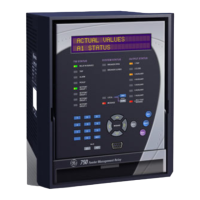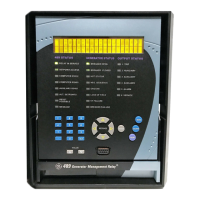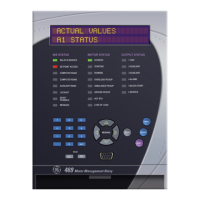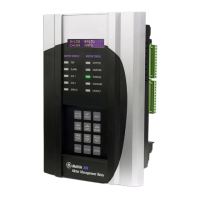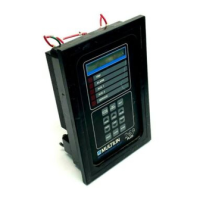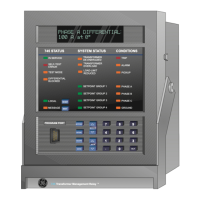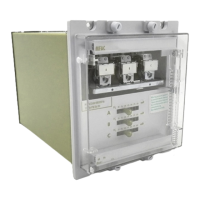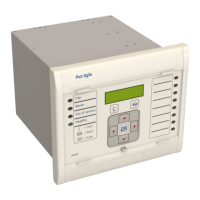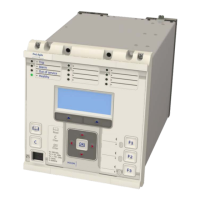Protection Schemes745
Transformer Management Relay
Commissioning
http://www.GEindustrial.com/multilin
7–36
GE Multilin
5. Reduce the voltage to below the S4 ELEMENTS !" FREQUENCY !" FREQUENCY
DECAY !" MINIMUM OPERATING VOLTAGE voltage supervision level.
6. Repeat ramping action and verify that element does not operate. If the voltage
supervision level has been set to 0.00, the element continues to operate
correctly down to approximately 2% or nominal.
7. Return voltage to nominal value.
8. If current sensing is enabled, set the current level below the
S4 ELEMENTS !"
FREQUENCY !" FREQUENCY DECAY !" MINIMUM OPERATING CURRENT value.
9. Repeat ramping action and verify that element does not operate.
10. For timing tests, an approximate operate time is obtained if a timer is triggered
at the same time as the ramping action and the time interval between the
trigger point and the relay operation measured. From that measured time,
subtract the time required for the frequency to reach the threshold value.
Current Input Function (Voltage Input Disabled):
1. Using a frequency-ramping programmable voltage/current source connected to
terminals H1 and G1 for the current signal, set the frequency to 60.00 Hz (or
50Hz). Set the current amplitude to rated CT secondary. Monitor the appropri-
ate trip and auxiliary relays. Reset all alarms and indications on the relay. The
relay display should remain unchanged with no trip indications.
2. Program the function generator to simulate a frequency rate-of-change just
above Rate 1. The start frequency should be the nominal frequency of the relay.
The end frequency must be below the Frequency Decay Threshold if the relay is
to operate. Note that operation occurs if the rate criterion is satisfied and the
frequency is below the threshold.
3. Initiate ramping action and verify that the element operates once the frequency
drops below the threshold.
4. Check that the Trip and Pickup LEDs are on and one of the following trip
messages is displayed:
LATCHED: Freq Decay Rate 1 or OPERATED: Freq Decay Rate 1
If the target was selected as “Latched”, the Trip LED and the message remain
on.
5. Set the current level to a value below the
S4 ELEMENTS !" FREQUENCY !"
FREQUENCY DECAY !" MINIMUM OPERATING CURRENT value.
6. Repeat ramping action and verify that element does not operate. If current
sensing has been disabled for this element, operation will continue down to a
current level of approximately 2% of nominal.
7. For timing tests, an approximate operate time is obtained if a timer is triggered
at the same time as the ramping action and the time interval between the
trigger point and the relay operation measured. From that measured time,
subtract the time required for the frequency to reach the threshold value. The
expected time must be computed using the rate of change and the effect of the
S4 ELEMENTS !" FREQUENCY !" FREQUENCY DECAY !" FREQUENCY DECAY DELAY
time delay.
Overexcitation a) Volts-Per-Hertz
The following procedure applies to both Volts-Per-Hertz elements; make the
necessary changes where appropriate. The volts-per-hertz operating levels are set
in terms of the relay-input voltage divided by the frequency of that voltage.
1. Disable all elements except Volts-Per-Hertz 1. Monitor the appropriate contact.
Use the test setup in FIGURE 7–12: Frequency Element Testing on page 7–31
with variable-frequency voltage source.
2. The Volts-per-hertz settings are found in the
S4 ELEMENTS !" OVEREXCITATION !
VOLTS-PER-HERTZ 1 setpoints menu.
